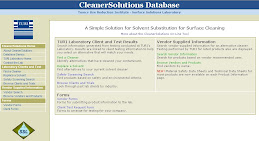Alternative Cleaning Testing
We have been busy this year having run 91 trials for 23 companies. Last year at this time we had run 44 trials for 15 companies. We are working on follow up projects for two wire and cable companies and have started working with a light bulb manufacturer.
The six case studies are still being worked on. One of these, looking at how the database can help companies find safer alternatives is nearing completion. Three others are ready to begin the internal review process.
Product Certification Testing
Several companies have been working with the lab to have products evaluated for performance so that the products can be certified by various environmental standards. Testing has been conducted for Green Seal certification for GS 8, 34 and 37. Additional work has been done for product certification for EPA's DfE Formulators project.
DIY Household cleaners
We are working on a “What Does This Mean” section to help people understand the health and safety information on the various ingredients of these recipes and how recipes compare to traditional cleaners. We have conducted lab testing on more recipes for performance. These recipes are used by the Brazilian Women's Group Co-op to support Brazilian house cleaners in their professions while creating community and promoting healthy and environmentally-friendly methods.
Database
Plans are in the works to start adding new features to the CleanerSolutions site. We are working on Search Wizard that will help guide users on how to select a cleaning process that will be best suited to their needs. In addition, we are adding more information on the health and safety of cleaning products beyond our five point screening process.
Outreach
The lab may be presenting on the database and other lab services at an upcoming event during March for Kansas State University Pollution Prevention Institute located in Wichita. The event is targeted at aerospace, auto body,printers, and misc solvent cleaners. The goal will be teaching participants how they can reduce solvent emission by changing the process, technology, and/or material.
We have been busy this year having run 91 trials for 23 companies. Last year at this time we had run 44 trials for 15 companies. We are working on follow up projects for two wire and cable companies and have started working with a light bulb manufacturer.
The six case studies are still being worked on. One of these, looking at how the database can help companies find safer alternatives is nearing completion. Three others are ready to begin the internal review process.
Product Certification Testing
Several companies have been working with the lab to have products evaluated for performance so that the products can be certified by various environmental standards. Testing has been conducted for Green Seal certification for GS 8, 34 and 37. Additional work has been done for product certification for EPA's DfE Formulators project.
DIY Household cleaners
We are working on a “What Does This Mean” section to help people understand the health and safety information on the various ingredients of these recipes and how recipes compare to traditional cleaners. We have conducted lab testing on more recipes for performance. These recipes are used by the Brazilian Women's Group Co-op to support Brazilian house cleaners in their professions while creating community and promoting healthy and environmentally-friendly methods.
Database
Plans are in the works to start adding new features to the CleanerSolutions site. We are working on Search Wizard that will help guide users on how to select a cleaning process that will be best suited to their needs. In addition, we are adding more information on the health and safety of cleaning products beyond our five point screening process.
Outreach
The lab may be presenting on the database and other lab services at an upcoming event during March for Kansas State University Pollution Prevention Institute located in Wichita. The event is targeted at aerospace, auto body,printers, and misc solvent cleaners. The goal will be teaching participants how they can reduce solvent emission by changing the process, technology, and/or material.








